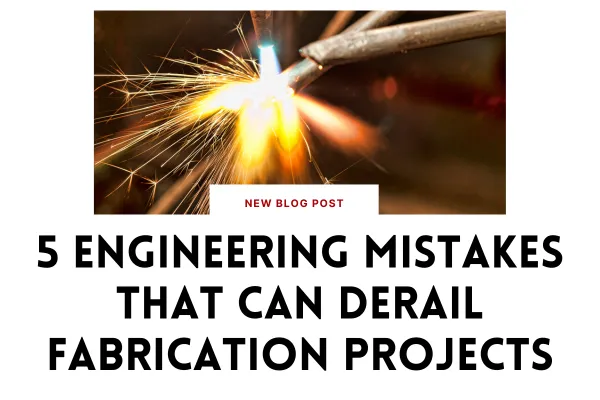
5 Engineering Mistakes That Can Derail Fabrication Projects
In the world of heavy steel fabrication and industrial manufacturing, even the smallest design oversight can ripple through production, delaying schedules and inflating costs. While advanced software and 3D modeling tools have enhanced engineering precision, some mistakes continue to surface—often not until it's too late. These errors compromise build quality, safety, and profitability. Here are five critical engineering missteps that must be avoided to ensure successful project delivery.
With that said, here are the 5 mistakes we keep seeing in projects, make sure to avoid them!
1. Only Looks Good on Paper
A model can appear flawless on screen, yet still be functionally unbuildable. When designs are developed in isolation from shop-floor constraints, they can result in assemblies that defy real-world feasibility. CAD environments allow for perfect alignment, infinite access, and theoretical precision. In contrast, the fabrication environment deals with tolerance accumulation, thermal distortion, physical weld access, and human limitations.
Best practice: Conduct constructability reviews involving welders, fitters, and production supervisors. Validate that designs account for realistic torch angles, clearance for clamps, and manufacturable dimensions. A drawing is not complete until it can be executed without workaround.
2. Lack of Understanding of Processing Equipment Capabilities

Every piece of shop equipment has mechanical limits. When engineers do not understand the operational envelope of plasma cutters, beam lines, press brakes, or CNC drills, they risk producing designs that create inefficiencies or require manual rework. The disconnect between digital expectations and physical limitations can lead to production bottlenecks, tooling damage, or the rejection of entire batches.
Common mistakes include:
Calling for hole diameters or spacing that fall outside of nesting tolerances.
Designing formed parts with internal bend radii below machine minimums, resulting in cracking or deformation.
Overlooking maximum table sizes or crane capacity during layout of oversized weldments.
Best practice: Maintain an up-to-date equipment capability matrix and reference it during design reviews. Include notes in the drawing package that clarify any assumptions about material handling or processing sequence. Align design intent with actual shop throughput capacity.
3. Missing Critical Fit-Up Dimensions or Assembly Logic
In complex weldments or bolted assemblies, missing a single key dimension can cascade into misalignment during fit-up. Engineers must understand not just the nominal geometry, but also how each component is located, fastened, and sequenced in assembly. Designs that fail to reflect how parts are physically brought together often result in torching, shimming, or field modifications that degrade overall quality.
Consequences often include:
Stiffeners, brackets, or flanges that interfere during installation due to incorrect offsets or projections.
Base plates or gussets that require field rework because bolt hole patterns were mirrored or incorrectly dimensioned.
Weld build-up or shrinkage not accounted for, leading to misfit during final assembly.
Best practice: Use 3D assembly simulations to verify fit-up logic and identify interferences. Clearly define datum schemes and dimension chains that reflect real-world setup practices. Design with installation tolerances in mind, and where necessary, allow for field adjustment features.

4. Failure to Accommodate the Dynamic Nature of Fabrication
Fabrication is rarely a static process. Material substitutions, expedited timelines, equipment failures, and customer-driven changes are common. Engineering teams that do not remain responsive to these variables often become a source of delay. Rigid designs and slow revision cycles prevent production from adapting in real time.
Symptoms of this failure include:
Drawings that cannot be adjusted without triggering a full engineering review, even for minor material substitutions.
Missing backup options for hardware, fasteners, or weld schedules in the event of procurement issues.
Slow turnaround on RFIs or clarification requests that halt progress on the shop floor.
Best practice: Engineer for flexibility. Include multiple acceptable material grades, alternate weld procedures, or optional hardware configurations. Create drawing packages that anticipate questions, and remain on-call during early stages of fabrication to resolve issues quickly. A responsive engineer is a production enabler.
5. Ignoring Handling, Rigging, and Shipping Constraints
The design process must extend beyond fabrication to include how components are lifted, rotated, transported, and installed. Failure to account for handling sequence, center of gravity, and load orientation can result in unsafe rigging practices, damage during transport, or installation delays. Structural members and heavy weldments must be designed with rigging logic in mind, not as an afterthought.
Best practice: Simulate the entire handling sequence in your 3D model, including rigging points, sling paths, and rotation clearances. Coordinate with logistics teams to confirm trailer constraints, bridge clearances, and staging procedures. Specify weld sizes and reinforcement at lifting locations to ensure safety during hoisting and placement.
Conclusion
Precision engineering is about more than getting the numbers right. It requires a deep understanding of the entire build lifecycle, from digital modeling to the clank of steel on the shop floor. Avoiding these five mistakes is not just about improving design—it is about enabling production, enhancing safety, reducing rework, and delivering value to your clients. True engineering excellence means delivering solutions that do not just exist on paper, but succeed in reality.

________________________________________________________________________________
Avoid common design mistakes!
5 Common Mistakes in heavy fabrication design and How to Avoid Them
Each mistake increases the risk of design failure or potentially cost your team to be past due & over budget.
DOWNLOAD OUR FREE GUIDE